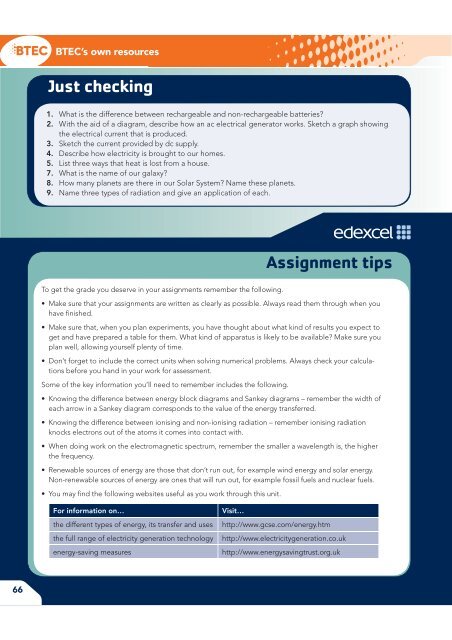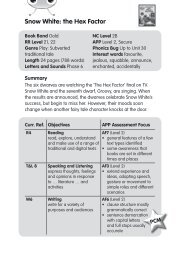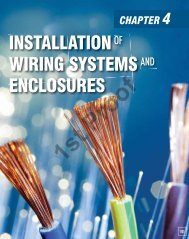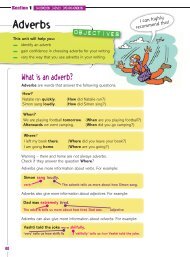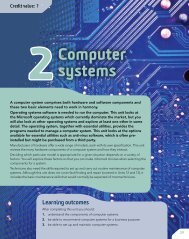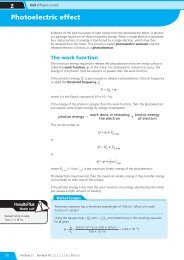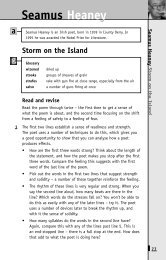Energy and our Universe - Pearson Schools
Energy and our Universe - Pearson Schools
Energy and our Universe - Pearson Schools
Create successful ePaper yourself
Turn your PDF publications into a flip-book with our unique Google optimized e-Paper software.
66<br />
BTEC’s own res<strong>our</strong>ces<br />
Just checking<br />
1. What is the difference between rechargeable <strong>and</strong> non-rechargeable batteries?<br />
2. With the aid of a diagram, describe how an ac electrical generator works. Sketch a graph showing<br />
the electrical current that is produced.<br />
3. Sketch the current provided by dc supply.<br />
4. Describe how electricity is brought to <strong>our</strong> homes.<br />
5. List three ways that heat is lost from a house.<br />
7. What is the name of <strong>our</strong> galaxy?<br />
8. How many planets are there in <strong>our</strong> Solar System? Name these planets.<br />
9. Name three types of radiation <strong>and</strong> give an application of each.<br />
To get the grade you deserve in y<strong>our</strong> assignments remember the following.<br />
Assignment tips<br />
Make sure that y<strong>our</strong> assignments are written as clearly as possible. Always read them through when you<br />
have fi nished.<br />
Make sure that, when you plan experiments, you have thought about what kind of results you expect to<br />
get <strong>and</strong> have prepared a table for them. What kind of apparatus is likely to be available? Make sure you<br />
plan well, allowing y<strong>our</strong>self plenty of time.<br />
Don’t forget to include the correct units when solving numerical problems. Always check y<strong>our</strong> calculations<br />
before you h<strong>and</strong> in y<strong>our</strong> work for assessment.<br />
Some of the key information you’ll need to remember includes the following.<br />
Knowing the difference between energy block diagrams <strong>and</strong> Sankey diagrams – remember the width of<br />
each arrow in a Sankey diagram corresponds to the value of the energy transferred.<br />
Knowing the difference between ionising <strong>and</strong> non-ionising radiation – remember ionising radiation<br />
knocks electrons out of the atoms it comes into contact with.<br />
When doing work on the electromagnetic spectrum, remember the smaller a wavelength is, the higher<br />
the frequency.<br />
Renewable s<strong>our</strong>ces of energy are those that don’t run out, for example wind energy <strong>and</strong> solar energy.<br />
Non-renewable s<strong>our</strong>ces of energy are ones that will run out, for example fossil fuels <strong>and</strong> nuclear fuels.<br />
You may fi nd the following websites useful as you work through this unit.<br />
For information on… Visit…<br />
the different types of energy, its transfer <strong>and</strong> uses http://www.gcse.com/energy.htm<br />
the full range of electricity generation technology http://www.electricitygeneration.co.uk<br />
energy-saving measures http://www.energysavingtrust.org.uk


